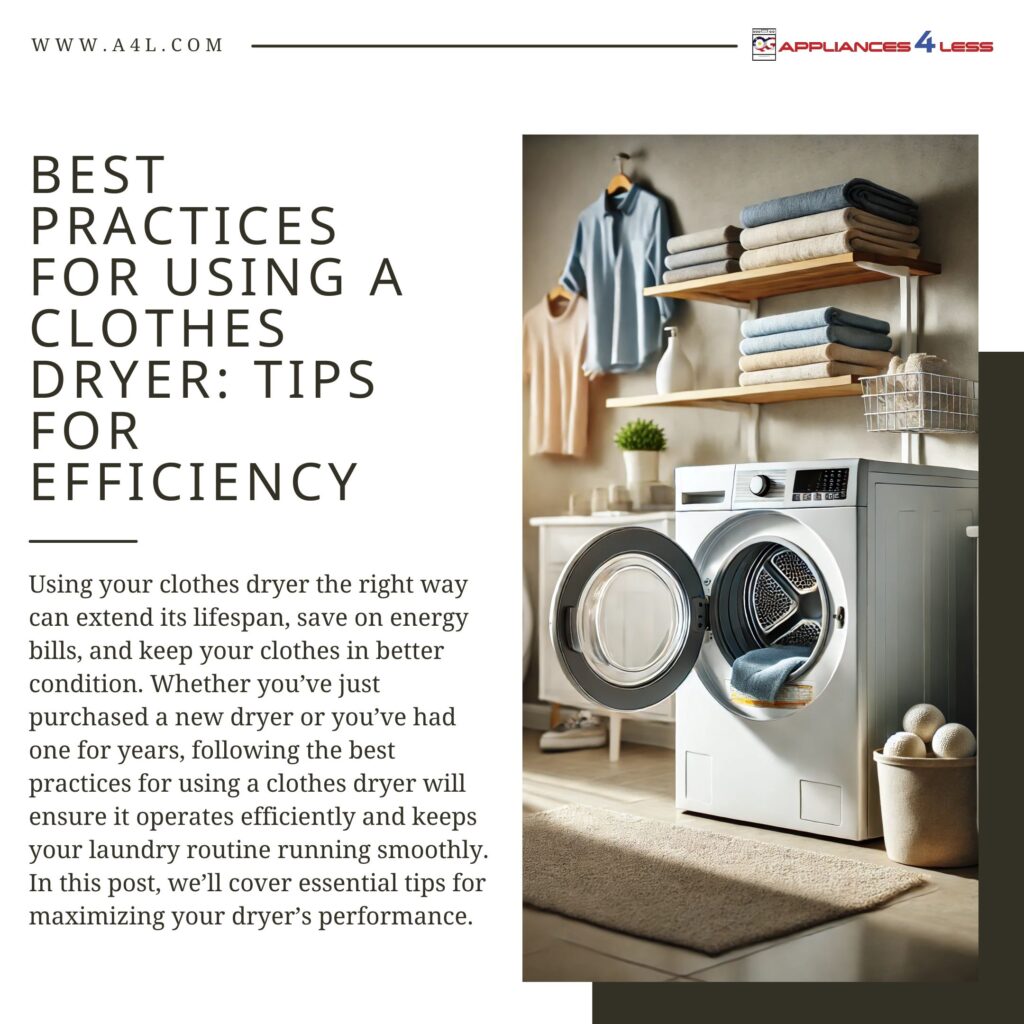Using your clothes dryer the right way can extend its lifespan, save on energy bills, and keep your clothes in better condition. Whether you’ve just purchased a new dryer or you’ve had one for years, following the best practices for using a clothes dryer will ensure it operates efficiently and keeps your laundry routine running smoothly. In this post, we’ll cover essential tips for maximizing your dryer’s performance.

Clean the Lint Trap After Every Use
One of the simplest yet most effective tips for maintaining your dryer is to clean the lint trap after every load. A clogged lint filter can block airflow, making the dryer work harder and use more energy. It can also become a fire hazard if left unchecked.
Best practice: Remove and clean the lint trap after each use to ensure proper airflow and efficiency.
Don’t Overload the Dryer
While it may be tempting to throw in as many clothes as possible, overloading the dryer can cause uneven drying and increase the amount of time your clothes need to spend in the machine. This not only wastes energy but can also lead to excess wear on your clothes.
Best practice: Load your dryer with the right amount of laundry, leaving enough space for the clothes to tumble freely.
Use the Right Dryer Settings
Modern dryers come with a variety of settings designed for different fabrics and drying needs. Using the wrong setting can over-dry delicate items or leave heavier items damp.
Best practice: Select the appropriate cycle for the type of load you’re drying. For example, use the “delicate” cycle for fragile fabrics and the “heavy duty” or “towels” setting for bulkier items.
Don’t Over-Dry Clothes
Over-drying your clothes can lead to unnecessary energy consumption and can damage the fabric. Many dryers come with moisture sensors that automatically stop the cycle once the clothes are dry.
Best practice: Use the dryer’s moisture-sensing feature to avoid over-drying and reduce wear and tear on your clothing.
Regularly Check the Vent and Duct
Your dryer’s vent and duct system play a crucial role in exhausting hot air and moisture. If the vent is clogged or obstructed, it can reduce the dryer’s efficiency and become a safety hazard.
Best practice: Inspect and clean the dryer vent and ducts at least once a year to ensure they’re free from lint buildup. This will help your dryer run more efficiently and reduce the risk of fire.
Dry Similar Fabrics Together
Grouping clothes by fabric type can improve drying efficiency. For instance, drying towels with delicate clothing can cause the lighter items to dry too quickly while the heavier fabrics remain damp.
Best practice: Separate heavy fabrics, like towels and jeans, from lighter materials, like shirts and undergarments, for more even and efficient drying.
Shake Out Your Clothes Before Drying
Before placing clothes in the dryer, give them a good shake. This helps prevent clothes from bunching up, which can lead to uneven drying.
Best practice: Shaking out clothes before loading the dryer allows them to dry more evenly and helps reduce wrinkles.
Use Wool Dryer Balls
Wool dryer balls are a great eco-friendly alternative to dryer sheets. They help reduce drying time by improving air circulation in the drum and can soften fabrics naturally without chemicals.
Best practice: Add two or three wool dryer balls to your load to reduce drying time and help soften clothes naturally.
Avoid Using the Dryer for All Clothes
While the dryer is convenient, not all clothes should be dried in it. Air drying delicate fabrics, workout gear, and items with elastic can help preserve their shape and longevity.
Best practice: Check clothing labels and air dry any items that might be damaged by the heat or tumbling motion of the dryer.
Keep Your Dryer in Top Condition
Performing routine maintenance is key to ensuring your dryer operates efficiently. Regularly cleaning the drum, inspecting the hoses, and keeping an eye out for strange noises or performance issues will keep your dryer running smoothly for years to come.
Best practice: Schedule regular maintenance checks to clean out lint buildup in the dryer drum and inspect hoses and vents for any blockages or wear.
Final Thoughts on Best Practices for Using a Clothes Dryer
By following these best practices for using a clothes dryer, you’ll save energy, keep your clothes looking fresh, and extend the life of your appliance. Whether it’s cleaning the lint trap or using the right settings, small steps can make a big difference in efficiency and performance.
At Appliances 4 Less, we offer a variety of energy-efficient dryers that make laundry day easier and more effective. If you’re looking to upgrade or need advice on maintaining your current dryer, our team is here to help!
Best practices for using a clothes dryer, clothes dryer efficiency, dryer maintenance tips, saving energy with dryer, dryer usage tips.